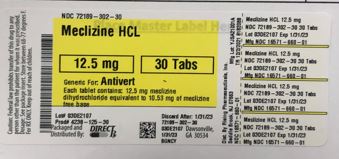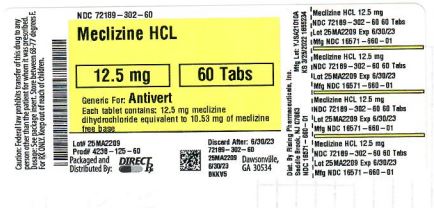MECLIZINE HYDROCHLORIDE tablet
MECLIZINE HYDROCHLORIDE by
Drug Labeling and Warnings
MECLIZINE HYDROCHLORIDE by is a Prescription medication manufactured, distributed, or labeled by DirectRx. Drug facts, warnings, and ingredients follow.
Drug Details [pdf]
- INDICATIONS & USAGE
-
DOSAGE & ADMINISTRATION
2.1 Recommended Dosage
The recommended dosage is 25 mg to 100 mg daily administered orally, in divided doses, depending upon clinical response.2.2 Administration Instructions
Tablets
Meclizine hydrochloride tablets must be swallowed whole.Chewable Tablets
Meclizine hydrochloride chewable tablets must be chewed or crushed completely before swallowing. Do not swallow chewable tablets whole. -
DOSAGE FORMS & STRENGTHS
Tablets
12.5 mg: oval-shaped, biconvex, two-layered tablet, one blue to pale blue layer debossed with “34” and one white to off white layer debossed with “L”.
25 mg: oval-shaped, biconvex, two-layered tablet, one yellow to pale yellow layer debossed with “49” and one white to off white layer debossed with “L”.
50 mg: oval-shaped, biconvex, two-layered tablet, one blue to pale blue layer debossed with “50” and one yellow to pale yellow layer and debossed with “L”.
Chewable Tablets
25 mg: pink colored round tablets debossed with “M 25” on one side and break line on other side. - CONTRAINDICATIONS
-
WARNINGS AND PRECAUTIONS
5.1 Drowsiness
Since drowsiness may occur with use of meclizine hydrochloride, patients should be warned of this possibility and cautioned against driving a car or operating dangerous machinery.Patients should avoid alcoholic beverages while taking meclizine hydrochloride [see DRUG INTERACTIONS (7.1)].
5.2 Concurrent Medical Conditions
Because of its potential anticholinergic action, meclizine hydrochloride should be used with caution in patients with asthma, glaucoma, or enlargement of the prostate gland. -
ADVERSE REACTIONS
The following adverse reactions associated with the use of meclizine hydrochloride were identified in clinical studies or postmarketing reports. Because some of these reactions were reported voluntarily from a population of uncertain size, it is not always possible to reliably estimate their frequency or establish a causal relationship to drug exposure.
Anaphylactic reaction, drowsiness, dry mouth, headache, fatigue, and vomiting. On rare occasions blurred vision has been reported.
-
DRUG INTERACTIONS
7.1 CNS Depressants
There may be increased CNS depression when meclizine hydrochloride is administered concurrently with other CNS depressants, including alcohol [see WARNINGS AND PRECAUTIONS (5.1)].7.2 CYP2D6 Inhibitors
Based on in-vitro evaluation, meclizine is metabolized by CYP2D6. Therefore, there is a possibility for a drug interaction between meclizine hydrochloride and CYP2D6 inhibitors. Therefore, monitor for adverse reactions and clinical effect accordingly. -
USE IN SPECIFIC POPULATIONS
8.1 Pregnancy
Risk Summary
Data from epidemiological studies have not generally indicated a drug-associated risk of major birth defects with meclizine during pregnancy. However, in a published study, an increased incidence of fetal malformations was observed following oral administration of meclizine to pregnant rats during the period of organogenesis, at doses similar to those used clinically.In the U.S. general population, the estimated background risk of major birth defects and miscarriage in clinically recognized pregnancies is 2-4% and 15-20%, respectively. The background risk of major birth defects and miscarriage for the indicated population is unknown.
Data
Human Data
Epidemiological studies reporting on pregnancies exposed to meclizine have not identified an association between the use of meclizine during pregnancy and an increased risk of major birth defects.Animal Data
In a published study, oral administration of meclizine (25-250 mg/kg) to pregnant rats during the period of organogenesis resulted in a high incidence of fetal malformations. These effects occurred at doses as low as
25 mg/kg, which is approximately 2 times the maximum recommended human dose (100 mg) on a body surface area (mg/m2) basis.8.2 Lactation
Risk Summary
There are no data on the presence of meclizine in human milk, the effects on the breastfed infant, or the effects on milk production. The developmental and health benefits of breastfeeding should be considered along with the mother’s clinical need for meclizine hydrochloride and any potential adverse effects on the breastfed infant from meclizine hydrochloride or from the underlying maternal condition.8.4 Pediatric Use
Safety and effectiveness in pediatric patients have not been established.8.5 Geriatric Use
In general, dose selection for an elderly patient should be cautious, usually starting at the low end of the dosing range, reflecting the greater frequency of decreased hepatic, renal, or cardiac function, and of concomitant disease or other drug therapy.8.6 Hepatic Impairment
The effect of hepatic impairment on the pharmacokinetics of meclizine has not been evaluated. As meclizine hydrochloride undergoes metabolism, hepatic impairment may result in increased systemic exposure of meclizine. Treatment with meclizine hydrochloride should be administered with caution in patients with hepatic impairment.8.7 Renal Impairment
The effect of renal impairment on the pharmacokinetics of meclizine has not been evaluated. Because of a potential for drug/metabolite accumulation, meclizine hydrochloride should be administered with caution in patients with renal impairment and in the elderly, as renal function generally declines with age.8.8 Genetic CYP2D6 Polymorphism
The genetic polymorphism of CYP2D6 that results in poor-, intermediate-, extensive-, and ultrarapid metabolizer phenotypes could contribute to large inter-individual variability in meclizine exposure. Therefore, when meclizine hydrochloride is administered to patients with CYP2D6 polymorphism, monitor for adverse reactions and clinical effect accordingly. -
DESCRIPTION
Meclizine hydrochloride, a histamine (H1) receptor antagonist, is a white or slightly yellowish, crystalline powder. It has the following structural formula:
struct-1Chemically, meclizine hydrochloride is 1-(p-chloro-α-phenylbenzyl)-4-(m-methylbenzyl) piperazine dihydrochloride monohydrate.
Tablets
Inactive ingredients for the tablets are: corn starch; dibasic calcium phosphate; magnesium stearate; polyethylene glycol; sucrose. The 12.5 mg tablets also contain: FD&C Blue # 1. The 25 mg tablets also contain: FD&C Yellow # 6 and D&C Yellow # 10. The 50 mg tablets also contain: FD&C Blue # 1, FD&C Yellow # 6 and D&C Yellow # 10.Each meclizine hydrochloride 12.5 mg tablet contains 12.5 mg of meclizine dihydrochloride equivalent to 10.53 mg of meclizine free base.
Each meclizine hydrochloride 25 mg tablet contains 25 mg of meclizine dihydrochloride equivalent to 21.07 mg of meclizine free base.
Each meclizine hydrochloride 50 mg tablet contains 50 mg of meclizine dihydrochloride equivalent to 42.14 mg of meclizine free base.Chewable Tablets
Inactive ingredients for the chewable tablets are: corn starch, colloidal silicon dioxide, FD&C Red # 40, lactose monohydrate, magnesium stearate, raspberry flavor, saccharin sodium, and talc.Each meclizine hydrochloride 25 mg chewable tablet contains 25 mg of meclizine dihydrochloride equivalent to 21.07 mg of meclizine free base.
-
CLINICAL PHARMACOLOGY
12.1 Mechanism of Action
The precise mechanism by which meclizine exerts its therapeutic effect is unknown but is presumed to involve antagonism of the histamine H1 receptor.12.2 Pharmacodynamics
There are no relevant pharmacodynamic data regarding meclizine.12.3 Pharmacokinetics
The available pharmacokinetic information for meclizine following oral administration has been summarized from published literature.Absorption
Meclizine is absorbed after oral administration with maximum plasma concentrations reaching at a median Tmax value of 3 hours post-dose (range: 1.5 to 6 hours) for the tablet dosage form.Distribution
Drug distribution characteristics for meclizine in humans are unknown.Elimination
Meclizine has a plasma elimination half-life of about 5-6 hours in humans.Metabolism
In an in vitro metabolic study using human hepatic microsome and recombinant CYP enzyme, CYP2D6 was found to be the dominant enzyme for metabolism of meclizine. -
NONCLINICAL TOXICOLOGY
13.1 Carcinogenesis, Mutagenesis, Impairment of Fertility
Carcinogenesis
Animal studies to assess the carcinogenic potential of meclizine have not been conducted.Mutagenesis
Genetic toxicology studies of meclizine have not been conducted.Impairment of Fertility
Animal studies to assess the effects of meclizine on fertility and early embryonic development have not been conducted. -
HOW SUPPLIED
16.1 How Supplied
Tablets
Meclizine hydrochloride 12.5 mg tablets are oval shaped, biconvex, two-layered tablet, one blue to pale blue layer debossed with “34” and one white to off white layer debossed with “L”.
Bottles of 100
Bottles of 500
Meclizine hydrochloride 25 mg tablets are oval shaped, biconvex, two-layered tablet, one yellow to pale yellow layer debossed with “49” and one white to off white layer debossed with “L”.
Bottles of 100
Bottles of 1000
Meclizine hydrochloride 50 mg tablets are oval shaped, biconvex, two-layered tablet, one blue to pale blue layer debossed with “50” and one yellow to pale yellow layer and debossed with “L”.
Bottles of 100
Chewable Tablets
Meclizine hydrochloride 25 mg chewable tablets are pink colored round tablets debossed with “M 25” on one side and break line on other side.
Bottles of 10016.2 Storage and Handling
Store at 20oC to 25oC (68oF to 77oF) [See USP Controlled Room Temperature].
Dispense in a tight, light-resistant container (USP). -
88436-1 - Section Title Not Found In Database
Administration Instructions
Advise patients that the tablets must be swallowed whole, but chewable tablets must be chewed or crushed completely before swallowing [see DOSAGE AND ADMINISTRATION (2.1)].Adverse Reactions
Advise patients that meclizine hydrochloride may cause anaphylactic reaction, drowsiness, dry mouth, headache, fatigue, vomiting and, on rare occasions, blurred vision [see WARNINGS AND PRECAUTIONS (5.1), ADVERSE REACTIONS (6)].
Inform patients that meclizine hydrochloride may impair their ability to engage in potentially dangerous activities, such as operating machinery or vehicles.Concomitant Drug Interactions
Advise patients regarding medications that should not be taken in combination with meclizine hydrochloride or that may necessitate increased monitoring [see DRUG INTERACTIONS (7.1, 7.2)]. Inform patients that alcohol may increase adverse reactions.Concurrent Medical Conditions
Advise patients to notify their healthcare provider about all of their medical conditions, including if they are pregnant or plan to become pregnant or if they are breastfeeding [see WARNINGS AND PRECAUTIONS (5.2), USE IN SPECIFIC POPULATIONS (8.1, 8.2)].PIA66201-00
Distributed by:
Rising Pharmaceuticals, Inc.
Saddle Brook, NJ 07663Issued: 08/2019
- PRINCIPAL DISPLAY PANEL
- PRINCIPAL DISPLAY PANEL
-
INGREDIENTS AND APPEARANCE
MECLIZINE HYDROCHLORIDE
meclizine hydrochloride tabletProduct Information Product Type HUMAN PRESCRIPTION DRUG Item Code (Source) NDC: 72189-302(NDC:16571-660) Route of Administration ORAL Active Ingredient/Active Moiety Ingredient Name Basis of Strength Strength MECLIZINE HYDROCHLORIDE (UNII: HDP7W44CIO) (MECLIZINE - UNII:3L5TQ84570) MECLIZINE HYDROCHLORIDE 12.5 mg Inactive Ingredients Ingredient Name Strength CALCIUM PHOSPHATE, DIBASIC, ANHYDROUS (UNII: L11K75P92J) SUCROSE (UNII: C151H8M554) WATER (UNII: 059QF0KO0R) POLYETHYLENE GLYCOL, UNSPECIFIED (UNII: 3WJQ0SDW1A) MAGNESIUM STEARATE (UNII: 70097M6I30) FD&C BLUE NO. 1 (UNII: H3R47K3TBD) ALCOHOL (UNII: 3K9958V90M) STARCH, CORN (UNII: O8232NY3SJ) Product Characteristics Color blue ((Pale Blue to White)) Score no score Shape OVAL ((Biconvex, two layered tablet)) Size 10mm Flavor Imprint Code 34;L Contains Packaging # Item Code Package Description Marketing Start Date Marketing End Date 1 NDC: 72189-302-30 30 in 1 BOTTLE; Type 0: Not a Combination Product 12/06/2021 2 NDC: 72189-302-60 60 in 1 BOTTLE; Type 0: Not a Combination Product 12/06/2021 Marketing Information Marketing Category Application Number or Monograph Citation Marketing Start Date Marketing End Date NDA authorized generic NDA010721 12/06/2021 Labeler - DirectRx (079254320) Registrant - DirectRx (079254320) Establishment Name Address ID/FEI Business Operations DirectRx 079254320 repack(72189-302)
© 2025 FDA.report
This site is not affiliated with or endorsed by the FDA.

